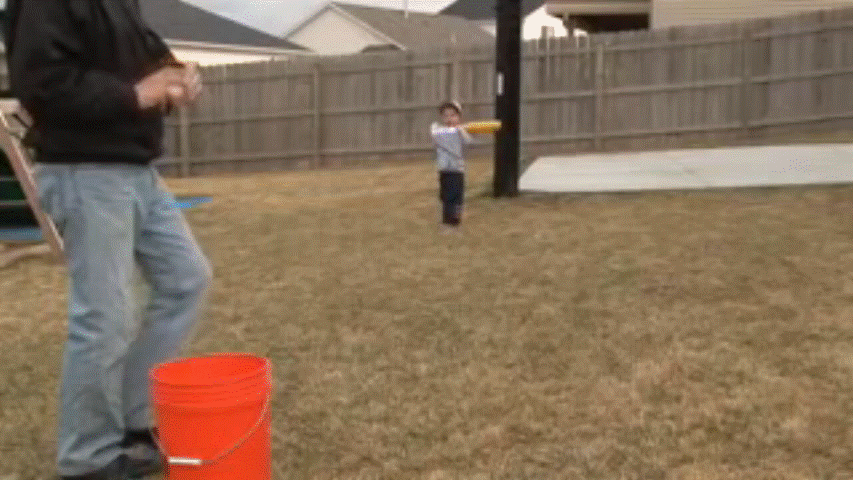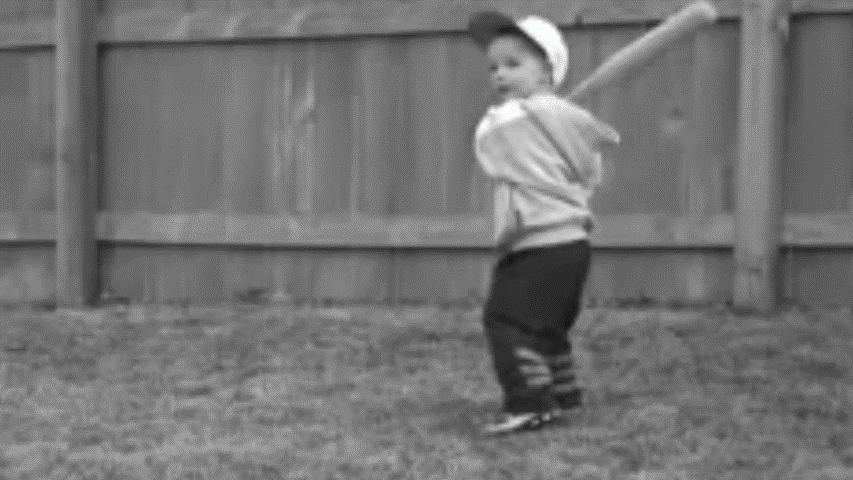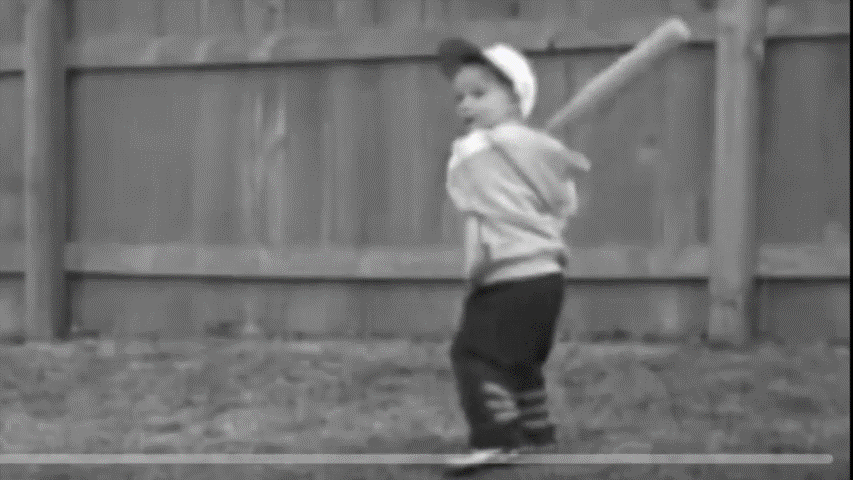
Subconscious Mastery in Hitting: Intent Over Instruction
By Ken Cherryhomes
Introduction
In this GIF, we observe a toddler effortlessly executing a swing that achieves both bat-ball intersection and an intent-driven outcome. This seemingly simple act reveals a sophisticated process where the toddler demonstrates an extraordinary, yet common ability. In real time, he selects an optimal intersection point based on the perceived kinematics of the ball, then predicts the balls trajectory as well as its velocity. Next, he anticipates the precise moment when the ball, which is slowing down, and his bat, which is speeding up, will intersect at the targeted position. To do this, he subconsciously draws on his memory of how long his swing takes, accounting for the transition of stored energy in his body into a smoothly accelerating motion. This seamless synchronization reflects an intricate, real-time calculation that even adults would find challenging to articulate. The child’s ability to orchestrate this sequence highlights the brilliance of the human subconscious, solving problems of incredible complexity without conscious reasoning.
This display of subconscious problem-solving underscores the depth of human potential in dynamic tasks. Despite lacking formal instruction, the toddler navigates the challenge of hitting by leveraging innate learning mechanisms, including pattern recognition and proprioceptive feedback. Each swing refines his motor plan through trial and error, integrating sensory input and past outcomes. The complexity lies not in executing a swing, but in achieving intent-driven precision—choosing where and how to strike the ball to influence its trajectory. This mastery of subconscious systems highlights a truth often overlooked in coaching: natural processes are the foundation of advanced skill acquisition and adaptation.
For coaches working with mature athletes, the toddler’s performance serves as a reminder of the dangers of over-intervention. Well-meaning attempts to impose mechanical corrections often risk overriding the subconscious processes that solve problems with unmatched efficiency. These interventions cannot account for the myriad variables the subconscious integrates—such as individual timing, proprioceptive calibration, intent-driven adjustments, physical strengths, limitations, and hardwired behaviors like gross or fine motor dominance. Effective coaching should support rather than disrupt this system, guiding athletes to trust their innate problem-solving capabilities while refining their motor plans through experience. By recognizing the brilliance of these subconscious mechanisms, coaches can foster more adaptable, resilient hitters who perform at their best under dynamic conditions.
Breaking Down the Problems Solved by the Toddler
To truly appreciate the brilliance of the toddler’s swing, we must examine the challenges he navigates effortlessly. Each swing represents a series of complex, interrelated problems that must be solved in real-time— tasks that transcend conscious reasoning that would challenge even the most analytical adult. By analyzing these challenges, we can better understand the natural intelligence driving his success and how it applies to coaching at all levels.

1. Temporal Prediction
The toddler doesn’t just predict when the ball will arrive; he selects an optimal intersection point based on split-second perception of the ball’s velocity, trajectory, and rate of deceleration. This decision, made in real time, involves a remarkable synchronization of sensory input and motor planning. His subconscious performs calculations that determine not only when to initiate the swing but also where the bat will intersect the ball for an intended outcome. This process is supported by:
- Visual Perception and Tracking: His eyes follow the ball’s movement, and his brain continuously updates predictions of its future position.
- Proprioceptive Awareness: He integrates his memory of how long it takes to swing the bat with the perceived kinematics of the ball, ensuring the bat arrives precisely at the chosen intersection point.
- Subconscious Memory of Motion: Through repeated attempts, the toddler’s brain refines its timing and coordination, allowing him to initiate his swing with confidence and accuracy.
2. Spatial Alignment
The toddler aligns his bat’s trajectory with the ball’s downward arc, ensuring they intersect at an optimal point of contact. This involves:
- Dynamic Adjustments: Micro-corrections occur mid-swing to account for slight deviations in the ball’s speed or trajectory. This process is referred to as online control.
- Task Simplification: Rather than overthinking, his subconscious reduces the problem to relative motion, using a consistent swing path that intersects the ball if timed correctly.
- Path Efficiency: Just as we naturally choose the most direct route when reaching for objects, the brain calculates the most logical and efficient path to the intersection point without conscious planning. This stands in contrast to coached swing paths that often impose inefficient routes to achieve specific outcome objectives—routes that our logical brain would instantly reject if allowed to solve the spatial problem naturally.
3. Energy Transfer
Without conscious reasoning, the toddler transfers potential energy stored in his body into kinetic energy in the bat, achieving:
- Kinetic Chain Efficiency: His legs, hips, torso, and arms work symbiotically to generate power and swing direction.
- Swing Acceleration Control: The swing accelerates non-uniformly, requiring precise coordination to ensure optimal impact.
4. Intent Beyond Intersection
This toddler demonstrates intent to lift the ball, not merely to make contact. His motor plan incorporates:
- Trajectory Matching: Aligning the bat’s angle with the ball’s downward path to produce lift.
- Outcome-Oriented Adjustment: A secondary objective, influencing how the ball exits the bat, reveals advanced motor planning.
The Role of Mental Limitations
The toddler’s inability to consciously reason or calculate highlights the incredible efficiency of subconscious systems. He lacks the cognitive capacity to:
- Perform mathematical computations: the calculation of bat ball intersection timing.
- Analyze pitch trajectory using explicit reasoning.
- Formulate detailed swing mechanics.
Yet, these limitations become an advantage. The toddler’s brain simplifies the task, relying on innate pattern recognition, predictive coding, and proprioceptive feedback. This underscores an essential truth: our subconscious systems are far better equipped to handle such complex, dynamic tasks than conscious interference could ever achieve.
The toddler’s swing is not just a charming display of childhood skill—it is a testament to the extraordinary problem-solving power of the human subconscious. By respecting and fostering these innate systems, we can help athletes at all levels achieve their full potential. Subconscious decision-making, driven by intent and natural adaptation, emerges as the foundation of successful hitting. The more we trust the subconscious, the more we unlock the true brilliance of the human mind and body.

The Physics Paradox
A fundamental truth often overlooked in hitting development is that the physics of the task remain constant across all levels of play. The requirements for bat-ball intersection and biomechanical execution do not change, whether the pitch is 40mph or 95mph. This creates a telling paradox in player development. Athletes are recruited to collegiate and professional levels specifically because their swing mechanics produced successful outcomes. However, when these same athletes face increased demands—higher velocities, more sophisticated movement profiles, and complex pitch sequencing—they may begin to struggle. In response, coaches often misinterpret the cause of the breakdown and dismantle the very mechanical patterns that earned them recruitment.
When faced with intensified demands, batters may experience regressions in their swing mechanics, reverting to what Nikolai Bernstein identifies as a base-level movement strategy—a primal, simplified motion aimed solely at intersection. This natural response to heightened challenges often stems from unsolved timing issues, not flaws in the underlying mechanics. However, coaches frequently misinterpret this regression as a mechanical problem and intervene by making unnecessary changes to the athlete’s swing. These overhauls disrupt proven movement patterns and fail to address the actual issue: the batter’s adaptation to increased timing constraints.
Preserving proven mechanics while focusing on timing solutions is essential to maintaining success as demands increase. This misdiagnosis not only disrupts what once worked but also creates unnecessary complexity by attempting to solve a timing problem through mechanical means. The mechanics that worked exceptionally well before would continue to succeed if the focus shifted to solving the timing problem rather than rebuilding the swing.
This misunderstanding of physics and timing extends into another common approach to improving performance: the pursuit of optimal metrics.
The Metrics Paradox
The growing focus on metrics like launch angle, exit velocity, and attack angle has significantly influenced how hitting is taught and evaluated. While these measurements provide insights into outcomes, they often distract from the core principles of successful hitting: timing and intent. This increased fixation on metrics comes at a cost—sacrificing bat-to-ball consistency in pursuit of metrics-based outcomes. By prioritizing numerical ideals over adaptability, hitters risk more swings and misses, undermining the foundation of effective performance.
The toddler’s swing exemplifies a profound truth: intent drives outcomes, not metrics. Without conscious reasoning or instruction, he instinctively generates an attack angle conducive to lifting the ball. This result is not achieved through replicating measured mechanics but through intent shaping his motor plan. His subconscious integrates timing, trajectory, and movement to achieve the desired result—an approach far removed from the rigid constraints of prescriptive metrics.
Metrics are byproducts of natural processes. They provide a retrospective understanding of success but cannot dictate how to achieve it. Attempting to reverse-engineer these numbers by making them the focus of training inverts the cause-and-effect relationship. The toddler does not aim for a specific launch angle; instead, his intent to lift the ball governs the mechanics that produce these outcomes. This critical distinction is often overlooked in modern coaching.
Overemphasizing metrics leads to rigid swings reconstructed to chase numerical ideals, stripping hitters of their natural adaptability. Specifically, batters risk:
- Reducing their bat’s time in the hitting zone while pursuing ideal attack angles,
- Losing their ability to react dynamically to varying pitch characteristics, and
- Overriding their subconscious problem-solving capabilities.
While metrics can serve as valuable diagnostic tools, they must remain secondary to the natural sequence of skill development. They are most effective when used to inform understanding, not dictate mechanics.
The lesson for coaches is clear: metrics should complement, not override, the innate processes that underpin successful hitting. By fostering intent-driven adaptability and respecting the natural integration of timing and mechanics, we can help hitters achieve sustainable, authentic performance—without reducing their swings to a pursuit of arbitrary numbers.
Pattern Recognition Under Pressure
As pitch velocities increase and movement becomes more sophisticated, batters must refine their pattern recognition systems rather than rebuild mechanics. This means developing earlier recognition of pitch characteristics and more efficient decision-making processes, allowing the original successful motor patterns to adapt naturally to increased demands without sacrificing fluid coordination.
The key to maintaining successful patterns lies in improving the batter’s ability to recognize and process pitch information earlier in flight. By focusing on pattern recognition and decision timing, batters can preserve their proven movement patterns while adapting to increased velocities and more complex pitch sequences. This approach acknowledges that the challenge isn’t mechanical but perceptual – the ability to gather and process information quickly enough to execute established movement patterns.
Early recognition and the experience gained from successful outcomes give batters greater control over the hitting event. This control creates the foundation for applying intent to the swing. When a batter can consistently recognize and time pitches earlier, they can progress through the essential sequence of objectives: first, accurately timing the intersection, then affecting an intent-driven outcome. This mirrors the toddler’s natural progression – only after solving the timing challenge can intent be effectively layered onto the swing to influence the batted ball’s trajectory.
Just as the toddler demonstrates natural pattern recognition in tracking and timing slower velocities, mature hitters must develop this same capability at higher speeds. This involves:
- Earlier pitch recognition through improved visual cues
- More efficient decision-making processes
- Better synchronization between recognition and action
- Maintained trust in established movement patterns
Creating Adaptive Systems
The ultimate goal is developing hitters who can maintain their natural problem-solving abilities across varying conditions and increasing demands. This requires an environment that systematically builds adaptability while preserving natural movement solutions.
First and foremost, training environments must prioritize timing challenges while supporting successful movement patterns. This means:
- Progressive exposure to increasing velocities
- Variable pitch sequences that challenge recognition
- Opportunities to solve timing problems without mechanical interference
- Focus on decision quality over immediate outcome success
The training environment should create conditions where intent emerges naturally from consistently solved timing constraints. Before pursuing intent-driven outcomes, coaches should:
- Allow batters to first master timing at each new velocity level
- Introduce varied pitch locations only after timing is reliable
- Let batters discover how their established patterns can achieve different outcomes
- Support natural adaptation rather than prescribing mechanical changes
Progress should be measured through adaptability rather than fixed metrics. Key indicators include:
- Ability to maintain timing across different velocities
- Quality of decisions in varying situations
- Consistency of movement patterns under pressure
- Capacity to layer intent onto successfully timed swings
Most importantly, the environment must build confidence in natural problem-solving processes. This means:
- Celebrating successful adaptations over perfect mechanics
- Understanding that temporary regression often precedes advancement
- Providing enough repetition for subconscious systems to adapt
- Maintaining faith in proven movement patterns even as demands increase
The Psychological Dimension
Success in hitting relies heavily on confidence, which stems from trusting one’s processes and the memory of successful outcomes. Under pressure, this trust can erode, leading batters to abandon their innate problem-solving capabilities in favor of conscious control. This shift typically reduces both performance and adaptability.
Relaxation plays a critical role in maintaining confidence and enabling high-level performance. When the mind and body are relaxed, brainwave activity tends to shift into alpha or theta states, which are associated with heightened focus, creativity, and a sense of flow. These brainwave states have been shown to slow the perception of time, allowing athletes to process information more effectively and execute actions with precision. In hitting, this can translate to better pitch recognition, faster decision-making, and improved swing execution.
One of the most effective methods for inducing these optimal states is through controlled breathing patterns. Intentional breathing not only calms the nervous system but also enhances the batter’s ability to stay present in the moment. Techniques such as diaphragmatic breathing or rhythmic inhale-exhale patterns help regulate heart rate, reduce stress, and synchronize physical movements with mental clarity. By mirroring the tempo of their movements during the load, stride, swing to the rhythm of their breathing —batters can create a harmonious connection between mind and body, enhancing both relaxation and precision.
Introducing these techniques in training helps athletes build a toolkit for high-pressure situations. By consciously practicing controlled breathing and associating it with specific movement patterns, batters can condition themselves to remain composed even in the face of challenging constraints. This not only reinforces their trust in subconscious processes but also prevents the erosion of confidence that often occurs under stress.
By embedding relaxation techniques, rhythmic breathing, and awareness of brainwave states into training, batters can unlock an edge that transcends mechanics. These methods not only enhance timing and precision but also build resilience under pressure, empowering athletes to trust their innate processes and perform with consistency in the game’s most demanding moments.
The Path Forward
The toddler’s example provides a compelling reminder of the optimal path to hitting success: solve timing first, then allow intent to shape outcomes. This sequence—rooted in natural problem-solving and subconscious processes—serves as a cornerstone for effective coaching. To honor and harness this principle, coaches should:
- Support the Natural Sequence: Reinforce the timing-first, intent-second methodology, ensuring that athletes retain their ability to adapt dynamically under pressure.
- Use Metrics as Context, Not Directives: Emphasize metrics as diagnostic tools to enhance understanding, rather than prescriptive standards that risk over-complicating the swing.
- Cultivate Confidence in Subconscious Problem-Solving: Foster trust in the athlete’s innate ability to make split-second decisions and execute fluid, adaptive movements.
- Prioritize Adaptability: Encourage athletes to embrace variability and challenge, helping them develop resilience and versatility as task demands escalate.
By adhering to these principles, coaches can help athletes preserve their natural problem-solving capabilities while refining their performance. The complexity of hitting doesn’t change from childhood to the major leagues—what evolves is the context in which the task is performed. The key to success lies in maintaining the fluid, intent-driven processes that come so effortlessly to the toddler, ensuring these abilities thrive as the demands of the game increase.
